Entre nous ...
By "Senior Subaltern", first published in the Canadian Army Journal, Vol. 5, No. 9, 1951. Accompanying cartoons were drawn by Capt GG McDermott, Dir. of Military Inteligence.
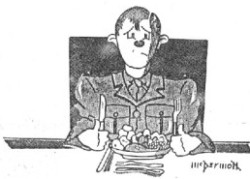
In our capacity, we are perhaps more aware than most people, of the "veritas nuda" of that old and well worn adage "There are always two ways of skinning a cat." It is for this reason that we were much interested in the article which appears below. The responsibilities of the "Senior Subaltern" are many, and are apt to vary with the customs and traditions of his Regiment. One duty, however, remains constant. The Senior Subaltern must ensure that the junior officers of his Regiment "get the form". There are no rules and no manuals to guide. "Entre Nous" was given as a lecture by a Senior Subaltern and, as such, indicates to us that we have not, although it comes as a shock, learned all there is to know about techniques of instruction.
Living, as we do, at least at the moment, in a more or less civilized world, it is necessary for all of us who are a part of anyone society to conform to a certain code of behaviour for the common weal. This code, is, as far as I know, for the most part an unwritten one but is nonetheless law. Hundreds of examples could be given but suffice it to say that you do not sit in a drawing room with one leg over the arm of your chair or leave your hat on while indoors or, having joined your hostess after dinner, stretch out in an easy chair and with a sigh undo your vest to allow your mid-riff a more comfortable distention. While the uninitiated might consider this latter action somewhat of a compliment to the host's fine foods such would not in fact be the interpretation put on it in shall we say, the better drawing rooms. My point is that while none of these actions does anyone any actual harm they are simply "not done" and consequently if some fellow inadvertently does do them, embarrassment is caused all round the business of living happily together within our civilized society is made more complicated. This is undesirable.
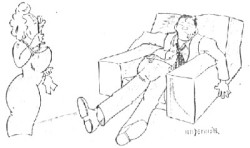
… having joined your hostess after dinner,
stretch out in an easy chair …
Come and get it!
Now it is an interesting (I hope) fact that a considerable portion of the time we spend in the company of others, we spend eating. Unless you are a "gulper" nearly two hours of each day is spent at the festive board. If you knock off eight hours sleep per night that means that 2/16 or 1/8 of your waking hours are spent eating or one year out of every eight! Horrors! Regardless of the accuracy of this arithmetic I am sure you can see that THE THING is terribly important and should be studied.
The Approach to Contact
This phase can be rattling to a tyro. At an informal dinner it is of course quite simple for you will normally be confronted with nothing more ominous than, on your right (ignoring your dinner partner) a soup spoon, dinner knife and bread knife in that order; on your left a dinner fork and across the top a dessert fork and spoon with handles heading to left and right respectively. At a formal dinner the array of eating utensils is, to say the least, formidable. They are, however, fortunately so arranged that you work solemnly in from the outer edges towards the centre. In any event you should always wait for your host or hostess to fire the starting gun, in which case he or she will give the final clue. If on the other hand one of them says, "Please do start or it will get cold", that must be taken as an order regardless of rank or seniority. In such a case you clutch at what you piously hope are the right tools and nine times out of ten all will be well. If by chance you get it wrong, cheer up—it doesn't really matter anyway.
At this point a brief word of warning to every young subaltern may be in order. While it is an accepted fact in Army circles that any young officer can eat three helpings of all courses and still leave the table hungry, there is always the possibility that you may be dining with civilians whose education may not be so advanced as to include this knowledge. Such a contingency must be trained for so that when your plate is placed before you, you can, by sheer will power prevent your eyes from popping out like organ stops. One good trick which will help you to master this difficult moment is to spend your time offering those in your vicinity salt, pepper, bread, butter, water—anything until you get the "go" sign.

… there is always the possibility
that you may be dining with civilians …
The Break-in
Under this heading I will discuss Standard Eating Practice (SEP) insofar as it concerns the weapons at hand i.e., the knife, fork and spoon. All weapons while subject to certain idiosyncrasies of the user, nevertheless have definite Tests of Elementary Training (TsOET). Based on SEP they are as follows.
The knife and fork are held identically, that is with the base of the handle in the palm of the hand, forefingers extended and braced against the weapon, the knife with the sharp edge of the blade down (unless of course you propose to cut your own or somebody else's throat) and the fork with the prongs pointing downward--No sir I don't care if the peas are hard as bullets, you must still wrestle with them that way or leave them. Neither is it permissible to, in exasperation, drop your knife and transferring your fork to your right hand scoop them up. That is considered cheating and simply isn't "cricket". If, however, you wish to pause to grab a fourth bun or if you just get tired you are allowed to rest but the rules state that both hands must rest at the same time. In such a case the knife is placed with the blade facing left and the fork with the prongs pointing downward. The tip of the knife and fork should be touching and the two should form an angle of approximately 30°. This is a signal to a well trained waiter that you propose to have another crack at the steak no matter how tough it is. To signal that you've had the whole thing the angle between the two weapons is closed and the prongs of the fork are turned upwards. The only exception to the above rule is when one is eating something which requires only a fork (such as some types of savoury or a piece of pie). In such cases the fork is, of course, held in the right hand and used with the prongs pointing upwards.
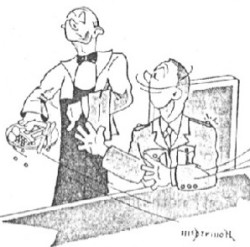
This is a signal to the well-trained waiter …
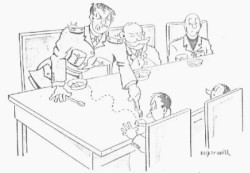
… holding it in the normal manner
and employing it as a pusher.
Desserts are a piece of cake (I beg your pardon). If it is a tricky one you may in addition to a spoon, use your dessert fork in your left hand holding it in the normal manner and employing it as a pusher—but only as a pusher—scooping is definitely not on. Even so it gives the bloke who likes cherries a tremendous advantage over his pea eating cousin and personally I've always felt that aspect of THE THING to be a bit unfair.
Just a word on the spoon. Hold it like a pen—which is exactly what you don't do with the knife and fork (that is by the SEP). Dessert spoons, you will find, will fit in the mouth and are therefore employed in this manner. Soup spoons, on the other hand, you will find (I hope) will not and are consequently sipped at daintily from the side. One must be careful not to sneeze during this process as the results of such an incident can be immediately catastrophic to the person sitting opposite you—and to you also, once the dinner is over. It is permissible to tip the plate very slightly by raising the side nearest to you. The soup is always gathered in the spoon by a motion of the spoon away from you. Both of these rules tend, like the side-sipping rule, to endanger your opposite number rather than you and are therefore good things.
The Dog Fight
Once committed to action the course of history is really pretty well set and the next step is to demolish the enemy. Just one word of warning here and that is - don't rush it. You are working to a timed programme so there is no point in finishing ahead of schedule. Keep the old pep talk going between bites and occasionally stop eating entirely and just sip at your champagne. During any such pause you may, if you are eating in your own kitchen, rest both elbows, and for that matter your head too, on the table if you so desire. If on the other hand you are dining at Government House I would recommend that you rest on nothing—not even your laurels. Between these two widely diversified dinner tables there is a sort of sliding scale as to how comfortable you may make yourself. The head and elbows should, of course, be whipped off smartly as soon as you leave the kitchen but as you yourself know even this rule has been known to go by the boards—the conviviality of the company, the length of the dinner and the lateness of the hour all have a bearing on this point. As a general rule I would say that one forearm rested on the table could call forth no adverse comments.
The Breakout
The trickiest opponents one is likely to be confronted with in this phase are the apple, the banana and the orange, and believe me my friend, these seemingly benign characters have tripped up many a worth opponent. The apple, for example, must never be eaten at dinner, as if you were enjoying it. That is to say you must not, grasping it firmly in one hand, sink your teeth into its juicy substance. Rather, must you cut it into segments so that each segment contracts a somewhat metallic taste from the knife. If you want to really stall for time, peel it. The banana is even trickier because the correct "breakout" phase approach to the banana is to daintily peel back the skin and, holding it steady on the plate with a fruit fork, cut it into segments with a fruit knife (as one would an eel—except not with a fruit knife) and eat it. (No—the banana not the eel! … Of course I mean with the fork—please try to follow the context!) As all of these implements are seldom available, I personally always look upon the banana as being purely ornamental.
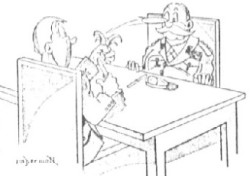
… the approach to the banana
is to daintily peel back the skin …
The orange, too, can be a stumper. It is not permissible to roll it between your hands and suck the juice out of one end nor is it permissible to cut the orange in half and scoop the juice out with a teaspoon. Both these methods have ruined too many mess jackets and tradition dies hard. The only permitted method is to peel the orange, preferably using a fruit knife, and dividing it into segments plop them down the gullet. Personally I always take grapes.
The Pursuit
The pursuit takes place after dinner and is consequently not within the scope of this paper. Suffice it to say that this most interesting and fast moving phase can develop along many lines, any of which I am sure you would find considerably more interesting than your studies to date. The theatre of operations and the battle experience of the troops involved both have a very strong influence on the course the action will take.
Rather than wait for the compilation of notes covering this phase of the attack the younger officers of the Regiment might be well advised to glean some earlier knowledge of this, a bachelor Captain is likely to be your best bet. Such an officer will not only have a good background of knowledge but is also most likely to have the advantage of having participated in any recent engagements of importance. If you want your instruction in technico1our buy him a double whiskey!
- The O'Leary Collection; Medals of The Royal Canadian Regiment.
- Researching Canadian Soldiers of the First World War
- Researching The Royal Canadian Regiment
- The RCR in the First World War
- Badges of The RCR
- The Senior Subaltern
- The Minute Book (blog)
- Rogue Papers
- Tactical Primers
- The Regimental Library
- Battle Honours
- Perpetuation of the CEF
- A Miscellany
- Quotes
- The Frontenac Times
- Site Map
QUICK LINKS
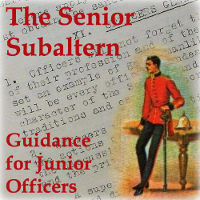
- The Senior Subaltern
- Staff Duties and the Young Officer
- How to Write Effective English
- Notes and Quotes - Staff Duties
- Advice to Officers (1782)
- Mess Rules of the Infantry School (1884)
- A Dozen Military Epigrams (1901)
- How The Loafer's Bred (1904)
- The Promotion and Examination of Army Officers (1904)
- A Few Tips for Officers, Before and After Joining (1906)
- Standing Orders of The RCR (1910)
- Standing Rules for Officers' Messes of The RCR (1913)
- The Young Officer's Guide to Knowledge (1915)
- The Duties of an Officer (1916)
- An Open Letter to the Very Young Officer (1917)
- Advice to a Young Officer (1917)
- Battalion Duties; Officers, NCOs, and Soldiers (1917)
- Pleasing Infantry Brigadiers (1917)
- Role and the Responsibilities of the CO in a Battalion Mess (1917)
- The RCR, "A" Company Standing Orders (1918)
- Some Staff Duties (1923)
- An Officer's Code (1925)
- Hints on Promotion Exams (1925)
- On Writing Appreciations (1926)
- The RCR; Rules for Officers' Messes (1927)
- Morale And Leadership (1929)
- RCSI Hints for Young Officers (1931)
- RCSI Notes on Drill (1931)
- The Study of War by Junior Officers (1932)
- Self-Training (1934)
- "The Problem of the First Ten Years" (1934)
- Standing Orders of The RCR; 1935)
- Customs of the Service (1939)
- Drill and Discipline (1939)
- Leaders Win Where Commanders Lose (1939)
- The Officer and Fighting Efficiency (1940)
- Officers' Mess (RCAF, 1940)
- The Duties of an Officer (1942)
- Comrades in Arms (1942)
- Example Standing Orders - Subalterns (1942)
- Hints for Newly Commissioned Officers (1943)
- Completed Staff Work (1943)
- FOLLOW-ship (1943)
- Hints for Junior Officers (1945)
- Officer-Like Qualities (1948)
- Military Writing (1948)
- An Analysis of the Sub-Unit Commander (1949)
- Leadership (1950)
- Neptune's Notes (undated, 1950s-60s)
- Thinking and Writing (1953)
- Examination Tactics (1953)
- Officers (1954)
- On Writing Examinations (1954)
- Customs of the Army (1956)
- 1st Bn, The RCR, Senior Subaltern (1956)
- Pigs Have Wings (1960)
- Leadership and Man Management (1960)
- Officers (1964)
- 1RCR - The Sergeants' Mess - "Tips" (1971)
- 2RCR Junior Officer's Handbook (1973)
- How to be a Successful Subaltern (1978)
- Foreword to the Infantry Journal, No. 8 (1979)
- Do You Appreciate the Finer Points of Life? (1980)
- The RCR Regimental Standing Orders - Senior Subaltern (1992)
- Infantry Company Command (2016)
- A Miscellany of Advice for Subalterns
- The Young Officer and the NCO - Quotes